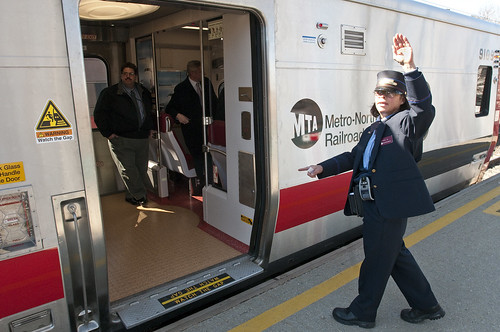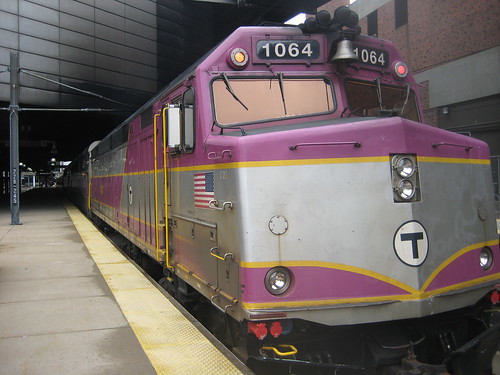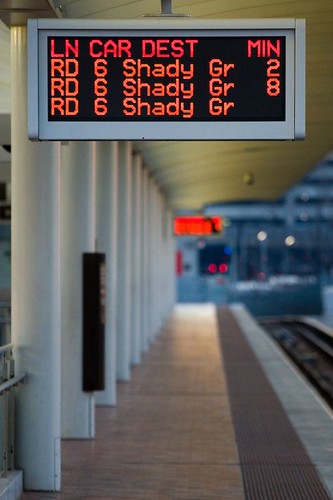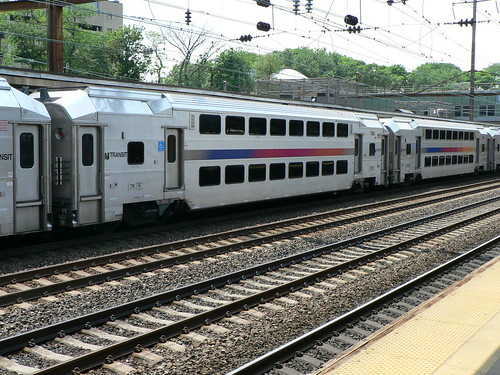
When Does "Operational Efficiency" Mean a Better MBTA?
Recently, a certain lobbying group has been arguing that the MBTA shouldn't be judged by how many people use it to get around, but rather by how many dollars it costs to run a vehicle for an hour or a mile. This cost per mile argument follows on the heels of their recently debunked assertion the that T is overfunded as compared to other transit agencies when looking at cost per trip. Those cost per trip comparisons didn't really make sensebecause they tried to compare the T to transit systems which provide vastly different services, which require different levels of investment to serve different populations (i.e., some agencies run only local bus or rail service, while the T does all of those, plus regional commuter rail, express buses, ferries, etc.).
So let’s address the cost per mile metric...
Above: Bus lanes in central London have improved operational efficiency of the bus network by increasing the number of people buses can move a given hour or mile [Photo: Andrew Nash]
Recently, a certain lobbying group has been arguing that the MBTA shouldn't be judged by how many people use it to get around, but rather by how many dollars it costs to run a vehicle for an hour or a mile. This cost per mile argument follows on the heels of their recently debunked assertion the that T is over-funded as compared to other transit agencies when looking at cost per trip. Those cost per trip comparisons didn't really make sense because they tried to compare the T to transit systems which provide vastly different services, which require different levels of investment to serve different populations (i.e., some agencies run only local bus or rail service, while the T does all of those, plus regional commuter rail, express buses, ferries, etc.).
So let’s address the cost per mile metric – it can be useful in certain circumstances but doesn't tell us much about the value of the service provided. Anyone who rides the T knows that the reason we run it is so that people can get from place to place, not so that we can spend the fewest dollars to run a vehicle for some time or distance, regardless of whether it serves anyone's transportation needs.
It's an axiom in business that you get what you measure. Doing better on some metric doesn't necessarily mean you're improving what you really care about. Keeping that in mind, let's consider some ways in which we could increase the T's "operational efficiency" as bound by the cost of T service per vehicle mile or vehicle hour.
Here are some bad ideas that would improve "operational efficiency":
- We could (but shouldn't) eliminate the Transit Police. They don't move a single vehicle and you only hear about them when trains are delayed because the Transit Police are looking for a person who, say, assaulted a rider.
- We could (but shouldn't) replace all Commuter Rail service with buses. Instead of one train you would need a bunch of buses and the trip would be slower. But if you're just looking at the math of "how many miles have been covered by how many vehicles for how many dollars?", then you'll think you have improved service.
- We could (but shouldn't) get rid of all bus service in or near Boston, and replace it with bus service that drove at a moderate speed along a quiet highway somewhere. You'd get much higher average speeds than say the 1 bus running through Boston and Cambridge, so yay for lower cost per mile but no one would ride it.
However, there are ways to reduce those operating costs per vehicle hour or mile which would actually improve service:
- We could replace subway cars more regularly, so that they don't break down as often - for instance, all the Orange Line cars are from roughly 1980 and haven't been upgraded since.
- We could buy more new buses so that they would break down less often and we would have more in reserve.
- We could give buses in high-traffic areas dedicated lanes, let them make traffic lights turn green - that's called signal priority, and let buses jump ahead of traffic where there isn't room for a dedicated lane on the whole length of the street. The most egregious place where buses should have signal priority is at D Street in South Boston, where the Silver Line, supposedly "rapid transit", waits over a minute at a light that's not even very busy.
- We could introduce HOV lanes on highways which buses travel on. This would let express buses and cars with multiple people skip the traffic on 93, the Pike, Route 3, and so on. People who waited hours for a Braintree shuttle bus this winter saw the impact of not doing this. One upcoming project which cries out for a bus lane is the replacement of the Tobin Bridge to Charlestown that the 111, 92, 93, 426 and 428 buses use - that's over 20,000 people a day on those buses who could save time if the new bridge got a dedicated bus lane.
- We could allow people to board buses and Green Line trains at all the doors and occasionally verify people have paid after they board. San Francisco's transit system MUNI did this; it makes buses and trolleys run faster and actually reduced fare evasion.
- We could change the Commuter Rail system to use electric power, as is happening in California. Electric trains can accelerate faster, which would speed up trips and let us serve more people with the same equipment. It should be possible to do this one line at a time and get the benefits for each line as it's electrified.
- We could build a train tunnel from North Station to South Station, the so-called North South Rail Link. That could make the Commuter Rail system more useful, for instance to riders who live north of Boston but want to get to South Station or Back Bay. It would also make it easier to do work on trains which run south of Boston, which currently have to make a roundabout trip to get to the only Commuter Rail maintenance facility, which is in Somerville.
As you can see, all of these useful changes either require political will or more money or both. So when people tell you that the T could improve its operational efficiency, tell them that you agree and you've got some ideas for how to do it.
Contributing editors: Ari Ofsevit, Jeremy Mendelson, Josh Fairchild, and Marc Ebuña
MBTA Releases Commuter Rail Realtime Data to Developers
Realtime data or: How I Learned to Stop Worrying and Love the Bus and How You Might Also Love the Commuter Rail
The MBTA released realtime bus tracking data for all bus routes at the end of last summer and they haven’t looked back. Realtime tracking of buses has taken most of the worry out of riding the bus; even if it does have its glitches, it’s reliable enough to make riding more accessible for a whole swath of people who had previously been averse to riding buses, including this blogger.
Yesterday, the MBTA opened even more data up to the development community with realtime tracking data for commuter rail. Josh Robin, Director of Special Projects and Innovation at the T, led the announcement, impressing upon developers the fact that the feed is still in beta since there are still gaps in the data. In order to improve the consistency of the data, various backend technologies and practises still need to be improved at the MBCR, the MBTA's contractor for commuter rail services.
Unlike buses and subway service where the greatest factor affecting customer perceptions is frequency, commuter rail is judged on its timeliness based on the published schedule. The feed will deliver not only the timeliness of a train, but also whether or not the train has stopped and it is unknown when the train will start again, as in instances where a train has broken down or there is any other blockage on the line.
The feed takes advantage of data that has already been available to the agency for internal management, as with the previous releases of realtime data for buses and subways. What's new is the formatting of that data into something that can easily be used by developers to make the numerous user-friendly apps that have been published to date.
Developers should be including the new data into their apps soon, making commuter rail just a bit more accessible and taking the guessing out of riders' commutes.
On track for progress
GM Rich Davey stopped by on his way out to thank the developers and answer any questions the crowd had. He reinforced the fact that releasing this data and enabling third parties to develop applications to make it useable for riders is part of his goal to find cost-effective ways of improving the accessibility of transit and the rider experience.
While I laud the MBTA for improving information delivery with a cost-effective solution (they have won numerous open data awards for their work), it only enables riders who own smartphones and is dependent on cellular network access. SMS bus tracking is available through NextBus, but no such service is available to riders for the Blue, Red, and Orange Lines and the recently added commuter rail. Further, cell service isn't available at every underground station (though that's slowly changing).
Ultimately, the MBTA needs to better format information on the many LED signs that are all over the system, including the commuter rail. At the moment, riders without smartphones or with no cell service only know when a train is near the moment an announcement is made - there is no persistent, in-station information about the next train, let alone the one following behind it.
I've spoken with the GM about this and he knows it needs to be done. Part of the problem is cost of labour to retool the system and the cost of hardware to upgrade some LED signs that don't have the resolution necessary to display some of this information. Meanwhile, the MTA in New York City is well on its way to have LED countdown clocks installed at every station, a system that was ultimately developed in-house at lower cost after many years of delays and budget overruns with outside contractors.
While countdown clocks won't solve the many infrastructure-related delays that happen each day, both here in Boston and in New York, it arms riders with the information they need to make split-second decisions about their commute if they can take alternate routes. This damage control approach to customer service is pretty much the only option to improve perceived quality of transit so long as transit agencies aren't given the money to bring their systems up to a state of good repair (the GM himself passingly lamented the fact that there simply isn't money to get new Red Line cars - because of a $2 billion shortfall in federal, state, and local funding, the current capital investment programme[PDF] for the next 5 years only includes $200 million for engineering and design of new Red and Orange Line cars, not purchase).
GM Davey - Executive Transit Rider
When I asked GM Davey what his favourite app was (in front of a room of app developers), he noted that he regularly used a web site, partly because he had to switch back to his Blackberry from his Android since it was having issues syncing with the MBTA's email services. He also noted that he had recently used the site on a trip via the 39 to dinner at Ten Tables in Jamaica Plain, for which he gave rave reviews. With that, I'm curious if there would be public interest in a (bi-)weekly blurb from the GM in the Metro about his experiences on the T.
Raising Safety, Efficiency, and Platforms
 With this winter's delays on the commuter rail, it's clear that legislators and MBTA and MBCR administrators need to push harder for better infrastructure and the funds with which to furnish it. But let's take a look at an issue that comes up every once in a while. Despite the MBCR's best efforts at preventing boarding and alighting accidents, through policy or physically securing doors, these accidents happen. In the winter, steps that accumulate ice from billowing snow kicked up as the train moves along can be a liability for passenger accidents and hampers boarding and alighting efforts, even increasing boarding times as people take their time to prevent slips and falls.
With this winter's delays on the commuter rail, it's clear that legislators and MBTA and MBCR administrators need to push harder for better infrastructure and the funds with which to furnish it. But let's take a look at an issue that comes up every once in a while. Despite the MBCR's best efforts at preventing boarding and alighting accidents, through policy or physically securing doors, these accidents happen. In the winter, steps that accumulate ice from billowing snow kicked up as the train moves along can be a liability for passenger accidents and hampers boarding and alighting efforts, even increasing boarding times as people take their time to prevent slips and falls.
I'm down on Long Island for a few days and I'm quickly remembering what fast, frequent, and convenient commuter rail service is like. I can take a train from Penn Station to my parents' stop out in Wantagh, over 50km or about the distance from Boston South Station to Worcester, and reliably be there in 1 hour. Trains on my branch run every 30 minutes to every hour, depending on time of day. This is not only because the electric M-7s the LIRR runs have better acceleration rates than diesel trains, but also because of how passengers can get on and off of the train.
When visiting most any other commuter railroad in first world countries or even our neighbouring commuter railroads to the south, the contrast is very clear. Passengers board and exit at any door along the length of the train from automated doorways that sense obstructions and prevent the train from moving if any of them are open. This is how heavy rail transit, like the Red, Orange, or Blue lines, operate (except when rollingstock on rapid transit is also so old that door sensors don't sense when people or objects are caught).
The top two commuter railroads, Metro North and Long Island Railroads, only have high-level platforms like those pictured above. On the MBTA network, very few stations have full high-level platforms and many have portions that exist only to make the stations ADA-compliant, the construction of which has been furnished by MBTA a multi-year, $1+ billion ADA compliance project.
Even if the Legislature and federal grants furnished the money required for the MBTA to raise its platforms, newer passenger cars (rollingstock) would still need to be purchased in order to fully seize the benefits of high-level boarding. The current and on-order bi-level cars have the latent ability to coordinate closing and opening of doors along the length of the train. Almost none of the older single level cars have this ability; conductors would need to go to every door to open and close them, otherwise lock doors in place to prevent the train from moving with open doors.
Newer commuter rail trains also benefit from the flexibility of having doors not located at end vestibules in order to allow passengers to board and alight more quickly since doors are more evenly spaced along the length of the train. New Jersey Transit's bi-level cars have 'quarter-point' doors, which sit over the trucks (the sets of wheels on a train), in addition to the conventional vestibular doors with 'trap doors' that permit low-level boarding. This isn't the most optimal door configuration, even for bi-level cars, but permits greater flexibility for passengers who are boarding or alighting at high-level platforms.
Aside from platform improvements, a capital expense that would likely cost tens of millions to billions to complete, depending on engineering practices and station geometries, there are several changes inside trains that can happen, namely electronic fare payment. The CharlieCard is now three years late in arriving on commuter rail and I quite frequently still see tweets of people thanking the MBTA for not coming to collect their fare on the train.
If you look at the conductor in the lede photo, you'll notice a small grey device on her belt - all Metro North conductors are equipped with one. This is a portable electronic ticketing machine and allows her to process credit and debit cards so passengers can pay for their fare without juggling cash. It is likely these machines can be upgraded to validate fare with RFID cards or future NFC technologies that the MTA is currently exploring with the MBTA and other regional transit operators. With deals and decisions to be made in the coming years, it's likely the MBTA and others are cooling their heels and waiting for a standard to come in before purchasing soon-to-be-outdated portable fare collection equipment. Long Island Railroad was promised these handy devices in about the same time as the MBTA Commuter Rail, but LIRR conductors still don't have them.
When all is said and done, both raising platforms, reconfiguring stations, and procuring portable fare collection devices will cost money, admittedly money no one seems to have, most especially the MBTA. Though, let's remember that these are expenses that fall under the capital budget, which is almost exclusively furnished by MassDOT, state grants, and federal grants from USDOT funding programs and other agencies. Much of these capital expenses can also be covered by investments from the private sector in the form of associated transit improvements to improve the appeal of or as part of transit-oriented developments around commuter rail stations.
These improvements need to happen in order to improve safety and running times of commuter rail trains, which already suffer from conditions not seen anywhere else in the burgeoning metropolitan regions of the Northeast Megaregion.
Note: MBTA Commuter Rail trains do have to make one accommodation that LIRR, Metro North, and most NJ Transit trains don't - MBTA shares many of its tracks with long, slow-moving CSX trains that are also important to Boston's economy. It will take a much greater amount of infrastructure investment to solve that problem, but that isn't to say DMU or EMU operation of MBTA Commuter Rail trains wouldn't improve service.
Categories
- Children (1)
- Diversions (1)
- Olympics (1)
- MAPC (2)
- Red–Blue Connector (2)
- Urban Design (3)
- Bus (4)
- Fares (4)
- Late Night Service (4)
- MBTA ROC (4)
- Silver Line (4)
- Snow (5)
- Blue Line (8)
- Emergency (8)
- Orange Line (8)
- Public Comment (8)
- Maintenance (9)
- Operations (9)
- Signage (9)
- Fare Collection (10)
- Labs (11)
- Safety (11)
- Planning (12)
- Communication (14)
- MBCR (14)
- MassDOT (14)
- Green Line (16)
- History & Culture (16)
- Red Line (18)
- MBTA Bus (21)
- Commuter Rail (24)
- Advocacy (26)
- Capital Construction (28)
- Politics (30)
- Podcast (35)
- News (38)
- Media (40)
- Funding (42)
- Statements (50)
- MBTA (57)





